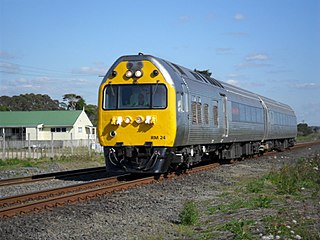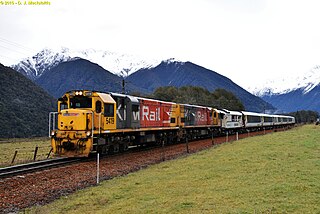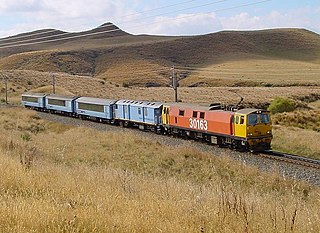
Rail transport in New Zealand is an integral part of New Zealand's transport network, with a nationwide network of 4,375.5 km (2,718.8 mi) of track linking most major cities in the North and South Islands, connected by inter-island rail and road ferries. Rail transport in New Zealand has a particular focus on bulk freight exports and imports, with 19 million net tonnes moved by rail annually, and 99.5% of New Zealand's exports and imports being transported through the country's seaports.
Tranz Metro was a New Zealand public transport operator. Beginning as the New Zealand Railways Corporation's Cityline division as a result of restructuring in the 1980s, in its final form Tranz Metro was the operator of Metlink's suburban trains owned by the Greater Wellington Regional Council in the Wellington Region of New Zealand.

The NZR RM class Silver Fern was a class of rail motor in New Zealand. The three air-conditioned and sound-proofed 723-kW 96-seater diesel-electric twin-set railcars were built by Kawasaki under contract with Nissho Iwai of Japan. New Zealand Railways (NZR) classified the railcars as RM (Rail Motor), the same as other railcars, using the Silver Ferns (a national symbol of New Zealand) because of their exterior was made of corrugated stainless steel, like the premier night sleeper train that also ran on the Wellington-Auckland (North Island Main Trunk) route, the Silver Star. The Silver Ferns replaced the three successful Blue Streak railcars on the service.

Public transport in the Wellington Region, branded under the name Metlink, is the public transport system serving Wellington and its surrounding region. It is the most used public transport system in New Zealand, and consists of electric and diesel buses, suburban trains, ferries and a funicular. It also included trams until 1964, and trolleybuses until 2017.
Transdev Auckland, formerly Veolia Transport Auckland, and Connex Auckland was a subsidiary of Transdev Australasia that ran Auckland's urban passenger trains under contract from Auckland Transport on infrastructure owned and managed by KiwiRail. Auckland Transport receives funding to subsidise these services from the NZ Transport Agency, which receives funding from road user taxes and Crown appropriations, and from the Auckland Council through rates.

The TranzAlpine is a passenger train operated by the Great Journeys New Zealand division of KiwiRail in the South Island of New Zealand over the Midland Line; often regarded to be one of the world's great train journeys for the scenery through which it passes. The journey is 223 kilometres (139 mi) one-way, taking almost five hours. There are 16 tunnels and four viaducts, with the Staircase Viaduct elevated as much as 75 metres (246 ft).

The Overlander was a long-distance rail passenger train between Auckland and Wellington in the North Island of New Zealand, along the North Island Main Trunk (NIMT). It was operated by Tranz Scenic. The service was replaced from 25 June 2012, by the Northern Explorer.

The New Zealand EM/ET class electric multiple units were used on suburban services in Wellington, New Zealand from 1982 to 2016. They were owned initially by the New Zealand Railways Corporation and finally by the Greater Wellington Regional Council (GWRC) and operated by Tranz Metro, part of national railway operator KiwiRail.

The Wairarapa Line is a secondary railway line in the south-east of the North Island of New Zealand. The line runs for 172 kilometres (107 mi), connects the capital city Wellington with the Palmerston North - Gisborne Line at Woodville, via Lower Hutt, Upper Hutt and Masterton.

The Coastal Pacific is a long-distance passenger train that runs between Picton and Christchurch in the South Island of New Zealand. It is operated by the Great Journeys New Zealand division of KiwiRail. It was called the TranzCoastal from May 2000 until temporarily withdrawn in February 2011. It was the first train to use the new AK class carriages.
The Waikato Connection was a short-lived express passenger train between Hamilton and Auckland in New Zealand's North Island. It consisted of a weekday single return service using diesel multiple unit railcars.

The Wairarapa Connection is a New Zealand interurban commuter rail service along the Wairarapa Line between Masterton, the largest town in the Wairarapa, and Wellington. It is operated by Wellington suburban operator Transdev under contract from the Greater Wellington Regional Council. It is a diesel-hauled carriage service, introduced by the New Zealand Railways Department in 1964 after passenger demand between Masterton to Wellington exceeded the capacity of the diesel railcars then used.

The Johnsonville Branch, also known as the Johnsonville Line, is a commuter branch line railway from the main Railway Station of Wellington, New Zealand to the northern suburb of Johnsonville via Ngaio and Khandallah.

Urban bus transport is the main form of public transport in New Zealand. Two of the country's largest cities, Auckland and Wellington, also have suburban rail systems, while some cities also operate local ferry services. There are no rapid transit metros and no remaining tram systems active anywhere in New Zealand, though trams once had a major role in New Zealand's public transport.

Maymorn railway station is a twin platform, rural request stop railway station serving the small settlement of Maymorn on the Maymorn Plateau, east of Upper Hutt, in New Zealand’s North Island. It is served by the Wairarapa Connection, and sees five services each way Monday to Thursday, six on Friday and two on Saturday and Sunday.
KiwiRail Holdings Limited is a New Zealand state-owned enterprise (SOE) responsible for rail operations in New Zealand and operates inter-island ferries. Trading as KiwiRail and headquartered at 604 Great South Road, Ellerslie, KiwiRail is the largest rail transport operator in New Zealand. KiwiRail has business units of KiwiRail Freight, Great Journeys New Zealand and Interislander. The company was formed in 2008 when the government renationalised above-rail operations and inter-island ferry operations, then owned by Toll Holdings. In 2021, the government launched the New Zealand Rail Plan, with funding for rail projects to come from the National Land Transport Fund (NLTF), and with KiwiRail remaining an SOE but paying Track Access Charges (TACs) to use the network.

The New Zealand FP/FT "Matangi" class is a class of electric multiple units used on the suburban rail network of New Zealand's capital city, Wellington. The class, consisting of an FP power car and an FT trailer car, operates services on all electrified lines of the network which comprise the Kapiti, Hutt Valley, Melling and Johnsonville lines. The units are owned by Greater Wellington Rail Ltd, a subsidiary of the Greater Wellington Regional Council (GWRC), and have been operated by Transdev Wellington under contract to the GWRC since 2016. They were previously operated by Tranz Metro, a former division of KiwiRail.

The New Zealand British Rail Mark 2 carriages were built by British Rail Engineering Limited for British Rail in the early 1970s. From the mid-1990s, 150 were exported to New Zealand. After being rebuilt, refurbished and re-gauged, they entered service with a variety of operators on New Zealand's railway network. The carriages generally replaced older NZR 56-foot carriages, some of which had been in use for almost 70 years.

Great Journeys New Zealand is the tourism division of KiwiRail that operate its three Scenic train services. The new division was launched in May 2017 and replaced the former tourism brand KiwiRail Scenic Journeys. It has continuity with the earlier InterCity Rail (1987–1995) and Tranz Scenic (1995–2011).

Te Huia is a passenger train service between Hamilton, Papakura, and Auckland in New Zealand. The service is a five-year trial with subsidies from the NZ Transport Agency and Waikato local authorities. The opening was delayed because of COVID-19 and the need to replace some rail track. A new starting date was announced, and the service began on 6 April 2021.



















